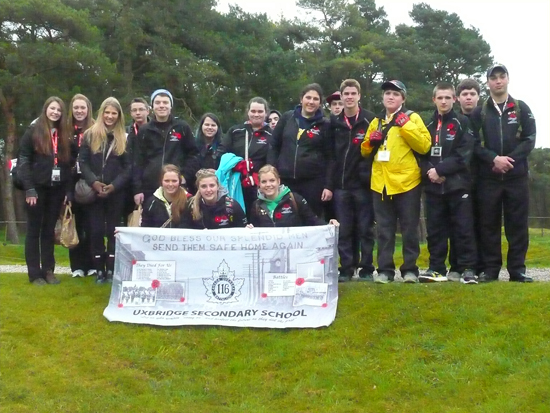
It had rained all day. The sun had tried to poke some light through the low-lying clouds and mist of the ridge. But the strong westerly wind – that seemed to cut right through you – quickly erased every attempt. It was not a day to be outside. And yet, people came by the thousand. In particular, the young Canadians – about 5,000 high school students – paraded with banners, cheers and a resolve that was characteristic of their forefathers. One of their teachers summed up the scene.
“They’re wet and chilled to the bone,” she said. “But they realize it’s not right to complain. They’ll get through it.”
This was Vimy Ridge on the 95th anniversary of the historic battle that changed both the momentum of the First World War and the status of the British Commonwealth nation on the northern half of North America. On April 9, 1917, nearly 100,000 Canadian soldiers – about the same ages as the young people observing the anniversary this week – climbed out of their trenches and took the ground that British and French armies had failed to wrest from the Germans the previous two years. The cost was severe – 10,000 casualties, including 3,495 dead – but for the first time in that war to end all wars, a force of colonial soldiers had prevailed and in the process, historians say, they gave birth to a nation – Canada.
Uxbridge Secondary School student, Liam Banks Batten has a sense of that moment. On Monday, the actual anniversary of the victory at Vimy, Liam and 17 classmates, marched through the same kind of wind and rain his great-great-cousin did 95 years ago. Wilford Joliffe (interviewed by the CBC in 1963) remembered “the whole sky was lit like giant fireworks,” when the creeping artillery barrage they had rehearsed led the way up the ridge. By the end of April 9, 1917, Joliffe’s battalion had achieved the unachievable; it had seized the ridge permanently.
“(Vimy) was the ideal attack made on a large scale in modern warfare,” Joliffe told the CBC 50 years ago.
And while history reported the elation of the victory, Joliffe’s young descendant, Liam, later researched and discovered that his ancestor had also witnessed enemy machine gun bullets rip his best friend to pieces; the young soldier had to cope with his chum’s blood on him for days. Similarly, Liam’s modern high school mate, Chris Perry, had researched another member of the Canadian Corps in the Great War – his great-great-uncle. Chris learned that James George Moore had enlisted in August 1914 and that his attestation papers revealed a unique body feature.
“Multiple tattoo marks on both arms,” the document said, “with a snake on his upper right arm.” But Chris had also learned his great-great-uncle was listed as missing and presumed dead during the first ever German Army gas attacks of April 1915.
Among the other U.S.S. students who marched up Vimy, last Monday, with stories of their ancestors in their heads, was Matthew Fearnley-Brown. As the rain pelted down on him that 95th anniversary afternoon, Matthew had memorized the history of his great-great-uncle. Ted Rogers, he told us, drove one of the first ambulances behind the lines at Vimy, but like so many he suffered the lasting effects of being gassed at Ypres. He later married one of the nurses who attended him in hospital.
“But unfortunately he died of tuberculosis in 1970,” Matthew said.
These were the stories the 18 students and their three teachers – Tish MacDonald, Carolyn Allen and Adam Cooper – carried with them up Vimy Ridge last Monday. As their ancestors had waited for all the preparations to be ready during that crucial battle to win that hilltop in 1917, so had the students waited in 2012. The broadcast equipment had to be readied. Security checks had to be carried out. The dignitaries had to arrive. All the while the rains and winds made the venue not unlike the muddy landscape Vimy veterans had known 95 years before.
But like their ancestors, the Vimy commemorators hunkered down under ponchos and other makeshift rain gear. And like their military predecessors, the students had to endure pronouncements from leaders. The French Veterans’ Affairs minister applauded Canadians’ “courage and diligence.” The Canadian Veterans’ Affairs minister called on Canadian youth to “pick up the torch of service.” And the Governor General of Canada applauded the students’ enthusiasm and resilience.
When the original Vimy veterans reached the top of the ridge, in 1917, the French press called their achievement “Canada’s Easter gift to France.” When the modern pilgrims reached the ridge top, last Monday, they heard average French citizens applaud them wildly. Among those citizens was a local electrical worker. When he was asked why he had given up his holiday Monday for an afternoon in a rainstorm, he shrugged:
“Back then, you came out for us,” he said. “Today, we come out for you.”